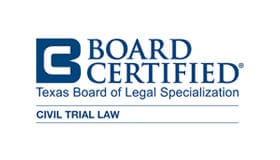Who Represents Whom? Travis County Jury Returns $1.29 Million Verdict Against DLA Piper
Texas Lawyer (Online)
A Travis County jury has returned a $1.29 million verdict against DLA Piper after finding the firm was negligent in failing to advise an Australian businessman that the firm did not represent him in a loan transaction with an Austin- based company.
“We’re very happy. We think we got our client’s money back. This is what he should have recovered if they did what they said they’d do,” says Jeffrey Taylor of The Akin Law Firm in Austin, who represents Linegar along with Taylor Dunham partner Don Taylor and associate Jennifer Tatum Lee.
Beck, Redden & Secrest partner Fields Alexander of Houston, one of the lawyers who represents DLA Piper, says, “The case is not over. . . . There’s been no judgment entered. There may be appellate issues. It’s still ongoing.”
Linegar sued DLA Piper in 2010 in connection with a loan to Austin company IdentiPHI Inc. In his fourth amended petition, Linegar allegedthat DLA Piper started representing him after his company, IdentiPHI LLC, merged in 2008 with another company represented by DLA Piper. The resulting company was called IdentiPHI Inc.
“Mr. Linegar allowed DLA Piper to serve as counsel for the ‘new’ IdentiPHI because they had experience with the SEC and in representing public companies and came highly recommended,” Linegar alleged in the petition.
Linegar alleged that DLA Piper did a substantial amount of work for him and “his companies,” and prepared the documents for a “bridge” loan Linegar made to IdentiPHI Inc. from money in his “superannuation fund,” which is like a 401(k) account. However, Linegar alleged DLA Piper never informed Rick Akin, Linegar’s U.S. counsel, of the loan transaction – a transaction that constituted a conflict of interest because it “pitted Mr. Linegar, as lender (and major shareholder) against IdentiPHI, as borrower.”
Linegar alleged that DLA Piper represented his loan was secure, yet it never “perfected” the security interest in the loan by filing a UCC-1 financing statement, with the result that after IdentiPHI Inc. filed for Chapter 11 bankruptcy in February 2009, Linegar recovered “only a fraction” of the nearly $1.7 million advanced under the bridge loan.
Additionally, Linegar alleged that DLA Piper had billed IdentiPHI Inc. for more than $690,000 in legal fees and it recovered more than $140,000 in the bankruptcy. “In other words, DLA Piper financially benefited from its wrongdoing,” Linegar alleged in the petition.
In its Second Amended Original Answer, filed on Nov. 7, 2011, DLA Piper denied the allegations in the petition and alleged that Linegar lacked standing to sue over the loan and to claim damages, among other things.
“Linegar was not a client of defendants, and therefore lacks the privity or capacity required to give him standing to bring suit,” DLA Piper alleged in the answer.
DLA Piper also alleged Linegar did too little to mitigate his potential damages.
On Feb. 23, a jury in the 345th District Court in Travis County returned a $1,293,606 verdict for Linegar attributing 90 percent of the responsibility to DLA Piper. The jury in Linegar v. DLA Piper US LLP found the firm was negligent in failing to advise Linegar it was not representing him; DLA Piper made a negligent misrepresentation to Linegar in connection with the loan on which he justifiably relied; there was an attorney-client relationship between DLA Piper and Linegar from Feb. 18, 2008, through June 17, 2008; DLA Piper’s negligence caused injury to Linegar; and the firm did not comply with its fiduciary duty to Linegar. The jury also found DLA Piper committed fraud by failure to disclose information.
Jurors attributed 10 percent of the responsibility to Linegar after finding his negligence caused or contributed to his injury.
DLA Piper had designated Akin & Almanza, a firm that represented Linegar in the merger transaction before the loan, as a responsible third party, but jurors found Akin & Almanza not responsible because its alleged negligence did not cause Linegar’s injury.
Jurors found DLA Piper did not commit fraud by misrepresentation to Linegar. The jury did not consider punitive damages, because it found DLA Piper did not act with malice when it breachedits fiduciary duty to Linegar. Jurors did not answer the questions of whether the injury resulted from gross negligence and/or malice of DLA Piper or whether the injury resulted from fraud committed by DLA Piper. [ See related documents: the plaintiffs’ fourth amended petition, the defendants’ second amended answer and the jury charge.]
Brian Kiefer, a spokesman in DLA Piper’s public relations department in Chicago, says, “The firm doesn’t comment on pending litigation it’s involved in.”
Rick Akin, a partner in The Akin Law Firm in Steamboat Springs, Colo., says the jury “clearly didn’t think Akin & Almanza was responsible at all, which I think was the correct answer.”
Akin says he founded The Akin Law Firm after he left Akin & Almanza in January 2010. He says he still represents Linegar in most of his U.S. business transactions, as he has since 2004.
Almanza, Blackburn & Dickie’s Boone Almanza of Austin, formerly of Akin & Almanza, says he’s pleased with the verdict but declines further comment. Akin & Almanza is the former name of Almanza, Blackburn & Dickie.
Make It Clear
Two experts say the case may highlight the need for corporate lawyers to be painstakingly clear that they represent the corporation itself, not officers or shareholders who develop business relationships with the lawyers.
“The general concept is you can’t serve two masters simultaneously and do justice to both,” says Steve Lee, who represents lawyers in State Bar of Texas disciplinary proceedings. Lee, a partner in Lione & Lee in Austin, adds, “[T]he individuals who speak for the company are not clients.”
Lee explains that lawyers who represent businesses must “constantly be vigilant” about who their clients are, which can be difficult.
“The lawyer who’s representing the business has to deal with individuals. . . . You end up with these relationships with these individuals, but they are not really clients. They are representatives of the client,” says Lee.
Austin solo and former State Bar Chief Disciplinary Counsel Jim McCormack says Linegar is “certainly a cautionary tale about allowing a lack of clarity to creep into client identification.”
McCormack says sometimes lawyers think “they’ve made it crystal clear” who their client is during a transaction, but it may not be clear to other players in the deal. A lawyer must tell others explicitly who he represents, and that his client’s interests may be adverse to the other party’s interests, he says, noting it’s best to put the disclaimer in writing.
Texas Lawyer senior reporter Brenda Sapino Jeffreys contributed to this article.
MORE PRESS
Retirees lost savings in fraud but won in court Insurance agent cheated women with high-risk investing, jury says
Retirees lost savings in fraud but won in court Insurance agent cheated women with high-risk investing, jury says Austin American Statesman In late 1998, Martha Eberhard says, her husband asked Austin insurance agent Danny Ballard how long it would take the...
Battle over visitor parking at Austonian could be bound for court
Battle over visitor parking at Austonian could be bound for court Austin American Statesman A battle over parking at a posh downtown Austin high-rise could be bound for court. In a lawsuit filed this week in Travis County District Court, the Austonian...
Bizarre life settlement drama in Texas nearing an end.
Bizarre life settlement drama in Texas nearing an end Investors to get their money back — in ten years or so Clients who invested some $80 million in life settlements that went awry may get their due. It's just going to take a while. About 900 investors shelled...




